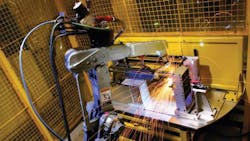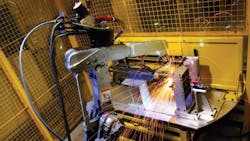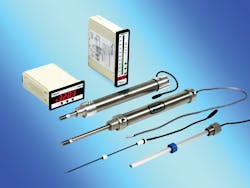Position transducers report in real time
Output lag times are inherent in some position transducers because signal-processing take time. In high-speed applications, this can mean that the controls only know where components have been recently, not where they are right now. If absolute linear-positioning data is important to an application, the TDP family of transducers — from Transducers Direct — incorporates a hybrid technology that offers a reliable approach to position sensing data.
In the TDP-100 version — configured to mount inside cylinders — a contact slides inside a tubular track. The track consists of a high-resistivity plastic film bonded to a wire-wound element. The special conductive plastic film is wiped by the self-cleaning, precious-metal contact.
This unit is essentially a modern linear resistive transducer. It acts as a voltage divider. If supply is a 10-Vdc signal, the output will be between 0 and 10-Vdc. If supply is 12-Vdc, the output will be between 0 and 12-Vdc. Most users choose 10-Vdc because most controllers have a 0 to 10-Vdc input module. (A magnetostrictive transducer typically would need a 24-Vdc supply. Its integral circuit board calculates the position, then converts this value in a digital-to-analog converter to produce the widely accepted 0 to 10-Vdc output signal.)
No such calculations or conversions are necessary with the TDP-100, so it requires no electronic boards and produces real-time outputs. The design needs no regular maintenance or re-calibration of the control system. The transducer also is very easy to troubleshoot; all you need to do is check the supply voltage against the output voltage.
Keeping current
Most applications work fine with the 0- to 10-Vdc output. However, for an electrically noisy environment (or if the user requests a different output), Transducers Direct offers a signal-conditioning module that converts 0- to 10-Vdc into a 4- to 20-mA or ±5-Vdc output for valve controller cards. Two advantages of current signals are that they are more immune to noise and can handle longer cable runs.
The hybrid technology provides infinite resolution and long life — because most of the current still flows in the wire, the conductive film’s carbon content is low, and the film is very hard. Linearity is 0.15%; the temperature coefficient of resistance is low (and predictable); and resistance stability under humid conditions is excellent. Most applications are repeatability dependent, so the TDP is well suited for cylinder- position feedback.
The TDP 100 can be supplied with a choice of in-cylinder mounting styles. The internal flange style is more suited to clevis style actuators; the pressure flange is suited to tie-rod style actuators. It fits through the cylinder end cap via an industry-standard ¾ - 16 threaded port.
Other versions of the same technology are designed with protective housings and IP-66 sealing for external-mounting applications, where gun-drilling the piston rod is not possible or feedback is needed from an existing cylinder.
Contact Transducers Direct, Cincinnati, at (513) 583-9491 or visit www.transducersdirect.com.



